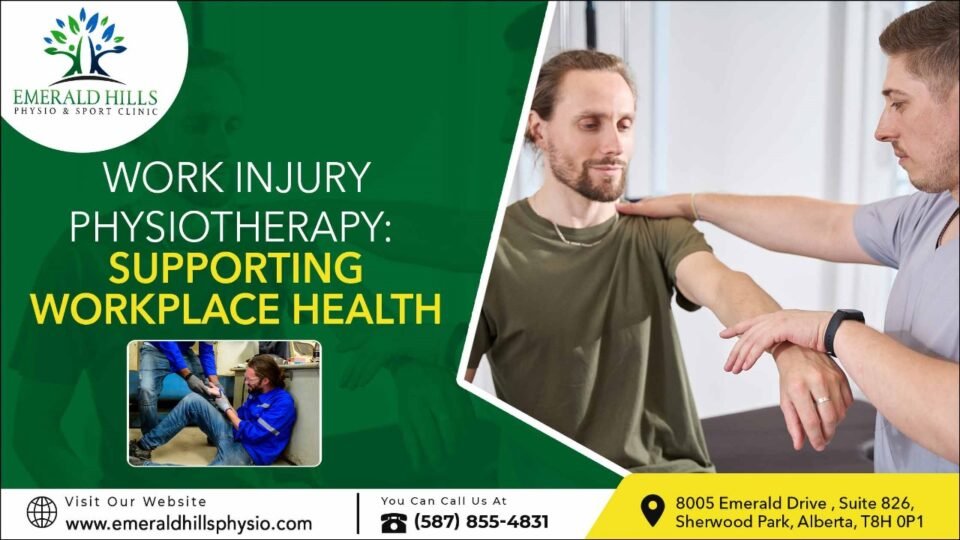In the fast-paced modern work environment, it is not uncommon for individuals to experience injuries. These injuries can stem from a range of causes, from repetitive strain due to office ergonomics to more acute incidents in labour-intensive roles. Enter work injury physiotherapy, a specialized approach designed to address these very issues, ensuring that individuals can return to their workspaces both safely and efficiently. Particularly in regions like Sherwood Park, institutions like Emerald Hills Physiotherapy have become pivotal in ensuring workers regain their health post-injury.
Understanding Work Injuries
Before delving into the solutions, it’s essential to understand the challenges. Work-related injuries can be:
- Repetitive Strain Injuries: Addressing conditions like carpal tunnel syndrome or tennis elbow, which can emerge from repetitive motions.
- Postural Syndromes: Helping workers address ailments resulting from prolonged sitting or standing.
- Occupational Overuse Syndrome: Discussing the potential of overusing particular muscle groups due to job requirements.
- Managing Chronic Pain: Techniques and exercises to manage and reduce chronic pain stemming from work-related conditions.
Comprehensive Recovery: The Multifaceted Approach of Work Injury Physiotherapy
1. Immediate Pain Relief:
Manual Therapy: This includes techniques such as joint mobilization or manipulation that can offer immediate relief from pain.
Electrotherapy: Modalities like TENS (Transcutaneous Electrical Nerve Stimulation) can alleviate pain.
2. Restoration of Movement and Function:
Range of Motion Exercises: Helps in restoring full movement to joints that have been compromised.
Functional Training: Tailored exercises that focus on getting the injured worker back to performing their specific job tasks without discomfort.
3. Strengthening and Conditioning:
Targeted Exercises: Aims to rebuild strength in weakened muscles post-injury.
Endurance Training: Builds stamina, ensuring the worker can perform tasks for extended periods without fatigue or risk of re-injury.
4. Improving Flexibility:
Stretching Routines: Address muscle tightness, which often accompanies or even precedes injuries.
Myofascial Release: A manual therapy technique that targets tightness in the fascia, the connective tissue surrounding muscles.
5. Addressing Postural Concerns:
Postural Training: Educating on and promoting proper posture to prevent strain, especially for desk workers.
Ergonomic Guidance: Advising on workspace setups to promote healthy postures.
6. Injury Education and Prevention:
Injury Mechanism Understanding: Explaining the cause of the injury helps in prevention.
Workplace Ergonomics: Providing advice on ergonomic adjustments in the workplace can minimize the risk of future injuries.
7. Mental and Psychological Support:
Counselling: Recognizing the mental toll of an injury, some physiotherapy approaches integrate counselling or therapy.
Confidence Building: Restoring a worker’s confidence in their physical capabilities, which can often be shaken after an injury.
8. Personalized Care:
Tailored Recovery Plans: Recognizing that every worker, job, and injury is unique, physiotherapy often involves crafting a personalized recovery plan.
Progress Tracking: Regular assessments ensure that the recovery is on track and adjustments to the treatment plan can be made as needed.
9. Rehabilitation for Return to Work:
Gradual Load Building: Ensuring that a worker can handle the physical demands of their job before fully returning to work.
Transition Programs: Some physiotherapists collaborate with workplaces to create gradual return-to-work programs, ensuring that workers aren’t overwhelmed as they reintegrate.
10. Holistic Approaches:
Dietary and Nutritional Advice: Ensuring that an injured worker’s diet supports healing and overall well-being.
Integration with Other Therapies: Combining physiotherapy with other treatments, such as chiropractic care or acupuncture, for comprehensive care.
In essence, work injury physiotherapy Sherwood Park is multifaceted, addressing not just the immediate physical repercussions of an injury but also the broader implications on a worker’s overall health, functionality, and well-being.
The Role of WCB Physiotherapy
The Workers’ Compensation Board (WCB) recognizes the importance of physiotherapy in the rehabilitation process of work-related injuries. WCB Physiotherapy Sherwood Park is designed to:
- Immediate Care: Address the injury promptly to reduce long-term impacts.
- Customized Treatment Plans: Personalized to the needs of the injured, ensuring a faster recovery.
- Education: Provide guidance on ergonomics and safe work practices to prevent future injuries.
- Continuous Monitoring: Regular follow-ups to track progress and modify treatment plans as necessary.
- Collaboration with Employers: Working together with businesses to make sure the transition back to the workplace is smooth for the injured.
Work Injury Prevention: Beyond Treatment
While treatment post-injury is paramount, prevention is equally significant. Some strategies adopted by work injury physiotherapy in Sherwood Park include:
- Ergonomic Assessments: Analyzing workspaces to ensure they are designed to minimize strain and risk.
- Workshops and Training: Educating workers about safe practices, proper lifting techniques, and the importance of regular breaks.
- Routine Health Check-ups: Offering regular health screenings to anticipate and prevent potential injuries.
- Personal Protective Equipment (PPE) Guidance: Providing recommendations on the correct usage of PPE based on the nature of the job.
- Flexibility and Strength Training: Propagating exercises that enhance physical resilience, thereby reducing the chances of injuries.
Prioritizing Worker’s Health
The contemporary work environment, with its myriad challenges, necessitates a proactive approach to health. With facilities like Emerald Hills Physiotherapy Sherwood Park, there is an emphasis on not just healing but also preventing work-related injuries. Through specialized work injury physiotherapy Sherwood Park and a focus on overall workplace wellness, we can envision a future where work injuries are significantly reduced, if not eliminated.


